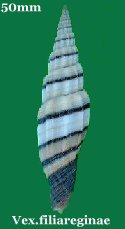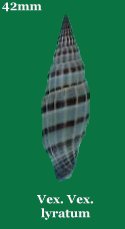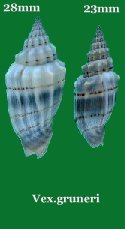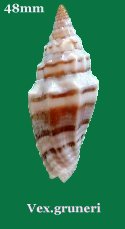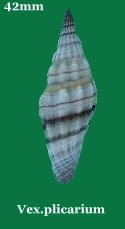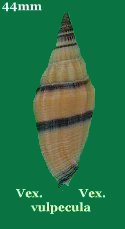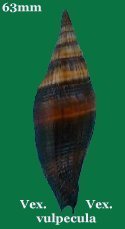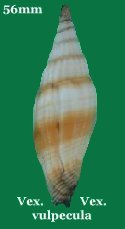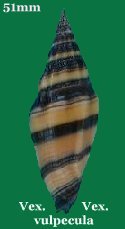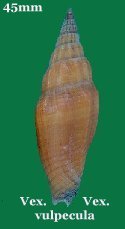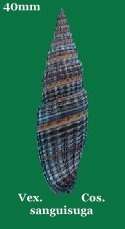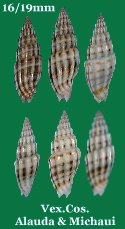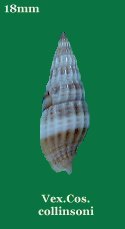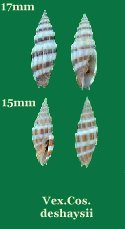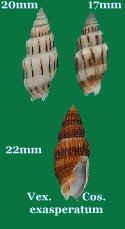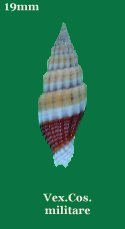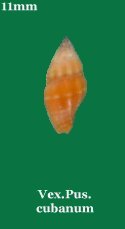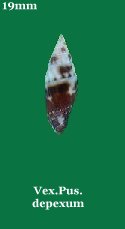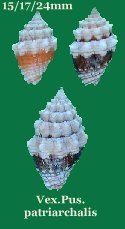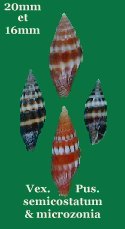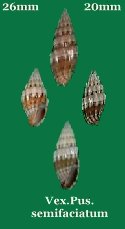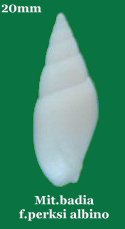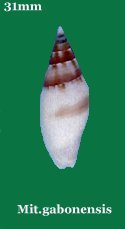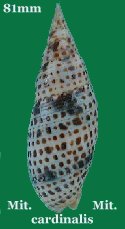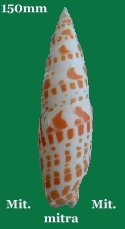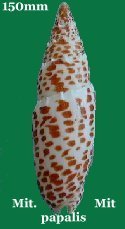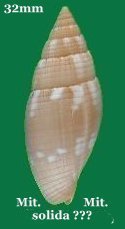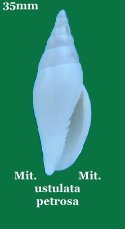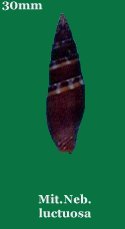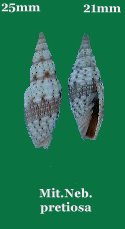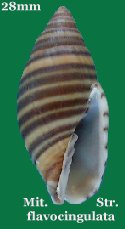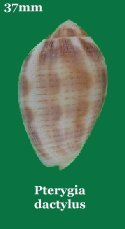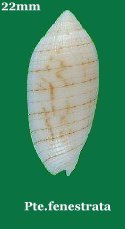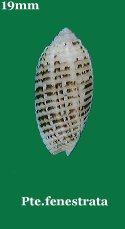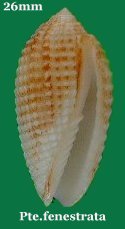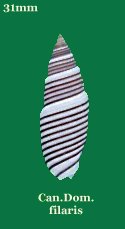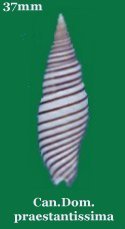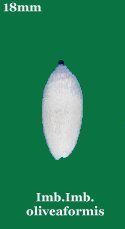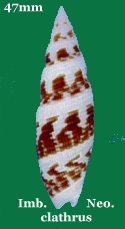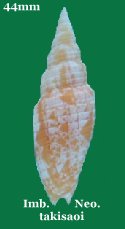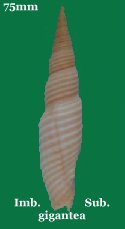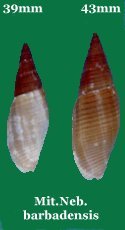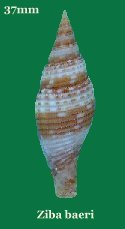|
This article is not a scientific one. It is an amateur work and is exclusively built with my collection material. It is probable, if not sure, that the Miters specialists will find some errors.
For instance, the aim is not to review all the living Miters nor to study them. This is not my intend. I only am a collector and I prefer to let this duty to the specialists. If my choice is to write this article, it is because I love this beautiful shells family, and my aim is to share this passion with other collectors.
For an easiest pictures understanding you can find hereby the different abbreviations for the sub families of the genus Mitridae :
|
|
|
Austromitra = Aus.
|
Imbricaria = Imb.
|
Pusia = Pus.
|
Thala = Tha.
|
|
Cancilla = Can.
|
Mitra = Mit.
|
Scabricola = Sca.
|
Vexillum = Vex.
|
|
Costellaria = Cos.
|
Nebularia = Neb.
|
Strigatella = Str.
|
Ziba = Zib.
|
|
Dibaphus = Dib.
|
Neocancilla = Neo.
|
Subcancilla = Sub.
|
Zierliana = Zie.
|
|
Domiporta = Dom.
|
Pterygia = Pte.
|
Swainsonia = Swa.
|
|
|
|
|
The second name will be in bracket. Example: one florida which is a Mitra (Diphabus) will be written : Mit.(Dib.) florida, (Gould, 1856).
|
|
|
|
|
|
|
|
|
It is quite difficult to speak about Miters. Despite they form a very great family, they are widely neglected by the collectors who, when diving for shelling will pick up cowries, cones, and other volutes, but will neglect a miter. Why? For two main reasons. Fist, because despite the great works of Mrs H. TURNER, W.O. CERNOHORSKY and nowadays by Mr. GUILLOT de SUDUIRAUT, there is only little written publication about miters. Secondly, as they are few miters collectors, their estimated value is quite unknown. When reading the dealer's list you will sea that, while the most popular families are very widely proposed, the Miters offer is very poor. It is comprehensive to beginners are not fond of Miters and choose the most popular shells.
Miters are mainly found in all the warm temperate seas, from the Pacific Ocean to the Caribbean and the Indian Ocean, East and West Africa areas. Even in the Mediterranean Sea, we can find some few and less coloured than in the warm oceans, which are the Vex. (Pus .) ebenus, (Lamark 1811), with a small size of about 20 mm ; the Mit. (Mit.) cornicula, (Linne 1758), about 30mm ; the Mit. (Mit.) nigra, (Gmelin 1791), about 35/40 mm ,and the more interesting one, the Mit. (Mit.) fusiformis zonata, (Mariat 1818), from about 90 to 100 mm. These last one have a periostracum witch can be light brown, or dark red or dark yellow.
|
|
|
|
|
|
ebenus (Lamarck 1811), cornicula (Linné 1758), nigra (Gmelin 1791), zonata (Marryat 1818)
|
|
|
|
|
|
You must go to the Philippines to find the most beautiful Miters. They are mainly Vexillium, at the head of which we find the citrinum, the filiareginae, the sanguisugua, the stainforthi …
So, I will start with the more famous sub family, the Vexillinae, (Thiele 1929), and for instance the more celebrated of them, the Vex. (Vex .) citrinum, (Gmelin 1791). It is quite big and can reach 100 mm, but its colour is quite constancy (you can see here its form compressa, (Sowerby 1874), which is smaller). On the contrary, the Vex. filiareginae, (Cate 1961), is as long, but the colours are very variable. With a little patience, you can collect a series of about twenty filiareginae of different colours.
|
|
|
|
|
|
|
|
|
|
|
|
(Gmelin, 1791)
|
|
|
|
(Sowerby, 1874)
|
|
|
The Vex.(Vex .) taeniatum, (Lamark 1811), with the forms tayloriana, (Sowerby 1874), coccineum , (Reeve 1844). The Vex. (Vex.) curvilyratum, (Sowerby 1874), and its forms adornata, (Tomlin 1920) ; formosence , (Sowerby 1890). The Vex. (Vex.) lyratum, (Lamark 1822).
|
|
|
|
|
|
Then are the well-known Vexillum by Miters collector, the gruneri, (Reeve 1844) and its very glossy form. The plicarium, (Linne 1758); the rugusum, (Gmelin 1791) and its form weberi, (Bartch 1918); the subdivisum (Gmelin 1791); the Vex. (Vex.) vulpecula (Linne 1758), with its form melongena (Lamark 1811); the Vex. (Vex.) mirabile (A.Adams 1853).
|
|
|
|
|
|
|
|
|
(Bartsch 1918)
|
(Gmelin 1791)
|
(Linné 1758)
|
|
|
|
|
|
|
|
|
|
|
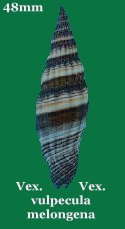
|
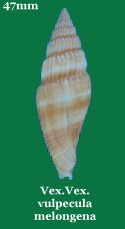
|
|
|
|
|
(Lamarck 1811)
|
|
(A. Adams 1853)
|
|
|
|
|
The Vexillum sub-genera Costellaria, (Swainson 1840). sanguisugua, (Linné 1758), (or sanguisugum ? or granosum ?), the Vexillum (Costellaria). rubrocostatum, (Habe 1966), the Vexillum (Costellaria) stainforthi, (Reeve 1842).
|
|
|
|
|
(Dautzenberg 1923)
|
(Habe 1966)
|
(Reeve 1842)
|
|
|
In the sub family Vexillum Costellaria, we find numerous small sized miters. They rarely measure over 50 mm, but are often very beautiful and coloured.
|
|
|
(Crosse 1864)
|
(H. Turner 1998)
|
(Reeve 1844)
|
(Adams 1864)
|
(Sowerby 1870)
|
|
(Gmelin 1791)
|
(Lamarch 1811)
|
(Reeve 1845)
|
(Reeve 1844)
|
(M.& S. 1899 ?)
|
|
(Adams 1853)
|
(Adams 1853)
|
(Reeve 1845)
|
(Smith 1874)
|
(Sowerby 1870)
|
|
(Reeve 1844)
|
(A.Adams 1853)
|
(A.Adams 1853)
|
(Reeve 1845)
|
(Reeve 1845)
|
|
(Reeve 1844)
|
(Reeve 1845)
|
(Gmelin 1791)
|
(Souwerby 1874)
|
(???)
|
|
(Reeve 1845)
|
(Adams & Reeve 1850)
|
(Cernohorsky 1974)
|
(Melville 1888)
|
(H.Turner 1994)
|
|
|
|
Here again, some very beautiful small Vexillum, the sub genus Pusia, (Swainson 1840).
|
|
|
(Reeve 1845)
|
(Sowerby 1920)
|
(Röding 1798)
|
(Anton 1839)
|
(Broderip 1836)
|
|
(Aguayo 1936)
|
(Deshayes 1834)
|
(???)
|
(Rehder 1943)
|
(Cernohorsky 1973)
|
|
(Reeve 1844)
|
(Cernohorsky 1973)
|
(Gmelin 1791)
|
(Reeve 1843)
|
(Hervier 1897)
|
|
(Cernohorsky 1976)
|
(Anton 1938)
|
(Lamarck 1811)
|
(Reeve 1844)
|
(Reeve 1845)
|
|
|
|
And now the Mitinae, (Swainson 1831), starting with the more popular the Mitra, (Lamark 1798) genus.
|
|
|
(Reeve 1844)
|
|
(Cernohorsky 1985)
|
(Biraghi 1984)
|
(Lamarck 1811)
|
|
|
The Mitra fulgurita form yaekoae, (Habe & Kosuge 1966), the Mitra subflava (Kuroda 1971), la Mitra (Dibaphus) florida, (Gould 1856), et multiplicata, (Pease1865).
|
|
|
(Habe & K. 1966)
|
(Kuroda 1971)
|
(Gould 1856)
|
|
(Pease 1865)
|
|
|
After the Dibaphus, the sub-genus Mitra (Mitra) (Lamarck 1798).
|
|
|
Sowerby 1829
|
Kiener 1838
|
Gmelin 1791
|
Reeve 1844
|
S.&.W. 1829
|
|
Cernohorsky 1980
|
Röding 1798
|
Cate 1968
|
Sowerby 1821
|
Röding 1798
|
|
Lightfoot 1786
|
Linné 1758
|
Gmelin 1791
|
Linné 1758
|
Cernohorsky 1970
|
|
Sowerby 1874
|
H.Turner 1993
|
A.Adams 1853
|
Reeve 1844
|
Link 1807
|
|
Von Martens 1804
|
|
Reeve 1844
|
Sowerby 1874
|
Reeve 1844
|
|
|
The sub-genus Mitra (Nebularia), (Swainson, 1840).
|
|
|
Gmelin 1791
|
Dorne 1861
|
Cernohorsky 1973
|
Hinds 1844
|
Lamarck 1811
|
|
Küster 1839
|
Lamarck 1811
|
Broderip 1836
|
Cernohorsky 1976
|
Reeve 1844
|
|
Wood 1828
|
A.Adams 1853
|
Sowerby 1821
|
Reeve 1845
|
Broderip 1836
|
|
Gmelin 1791
|
Reeve 1844
|
Pease 1860
|
Wood 1828
|
Reeve 1845
|
|
Crosse 1862
|
Lamarck 1811
|
Reeve 1844
|
Reeve 1844
|
Reeve 1844
|
|
|
The sub-genera Mitra (Strigatella) (Swainson 1840).
|
|
|
Sowerby 1824
|
Kiener 1838
|
Lamy 1938
|
Dillwyn 1817
|
Lamarck 1811
|
|
|
|
Followed by the sub-family Cylindromitrinae (Crossmann 1899) genus (Röding 1798).
|
|
|
Gmelin 1791
|
Broderip 1836
|
Reeve 1845
|
Gmelin 1791
|
Linné 1767
|
|
Sowerby 1823
|
Gmelin 1791
|
|
Linné 1758
|
Reeve 1844
|
|
|
Genus Scabricola, (Sowerby, 1840), sub-genus Swainsonia, (H.& A.Adams, 1853).
|
|
|
Sowerby 1823
|
Gmelin 1791
|
|
Lamarck 1811
|
Sowerby 1831
|
|
|
|
And now to stop this little presentation of the Mitridae family, the last great sub family :
The Imbricariinae (Troschel, 1967), with the genus Cancilla (Souwerby, 1840), Imbricaria (Imbricaria) (Schümacher, 1817), Neocancilla (Cernohorsky, 1966) Scabricola (Swainson, 1840), Subcancilla (Olsson & Harbison, 1953), Ziba (H.& A. Adams, 1853). The sub-genus Domiporta (Cernohorsky, 1970) et Swainsonia (H. & A. Adams 1853).
|
|
|
Reeve 1844
|
Linné 1771
|
Cernohorsky 1970
|
Lamarck 1811
|
|
|
Lamarck 1811
|
Dohrn 1972 ?
|
Röding 1798
|
|
|
|
Ad.& Ree.1850
|
Sowerby 1831
|
A.Adams 1855
|
Cernohorsky 1970
|
Lamarck 1811
|
|
Sowerby 1921
|
Q.& G. 1933
|
Gmelin 1791
|
|
|
|
Reeve 1845
|
Cate 1962
|
Link 1807
|
Kuroda 1959
|
Cate 1968
|
|
Reeve 1845
|
CB.Ad.1853
|
Gmelin 1791
|
Cernohorsky 1981
|
|
|
|
|
Schmeltz 1911
|
|
Reeve 1844
|
|
Q.& G.1833
|
|
Dunker 1858
|
Reeve 1844
|
|
Petit 1852
|
Sowerby 1825
|
|
Reeve 1845
|
Reeve 1844
|
Berry 1960
|
|
Tomlin 1931
|
|
Reeve 1844
|
???
|
Webb 1958
|
Gmelin 1791
|
Finlay 1927
|
|
|
The sub-genus Mitra (Pleioptygma) helenae (Radwin & B. 1972) & the sub-genus Vexillum (Zierliana) (Gray 1847).
|
|
|
Q.& G.1833
|
Radwin & B. 1972
|
Kiener 1838
|
Gmelin 1791
|
Reeve 1844
|
|
|
???
|
H.Turner 1993 ???
|
???
|
???
|
|
|
|
My little show is finish now. For instance, I have a lot of other miters, but too small to be pictured even with a macro camera. I also have other well-known species but to present them would be too heavy and misunderstanding. I will receive your remarks with pleasure concerning the species and eventually for corrections proposals.
Documents used to classify my collection of Mitridae :
THE MITRDAE OF THE WORLD Part I . The Subfamily Mitrinae by Walter O. CERNOHORSKY
THE MITRDAE OF THE WORLD Part 2 . The Subfamily Mitrinae concluded and Subfamilies Imbricariinae
and Cylindromitrinae by Walter O. CERNOHORSKY
MITRE SHELLS From the Pacific and Indian Oceans by PETER PECHAR CHRIS PRIOR BRIAN PARKISON
CARD CATALOGUE OF WORLD-WIDE SHELLS Pack # 9 MITRIDAE Part III & IV by Sally Diana KAICHER
INDEX OF MITRIDAE STUDIES by Jean Claude CAILLIEZ
BULLETIN DE LA SOCIETE INTERNATIONALE DE CONCHYLIOLOGIE CH-1001 LAUSANNE Suisse
|
|

